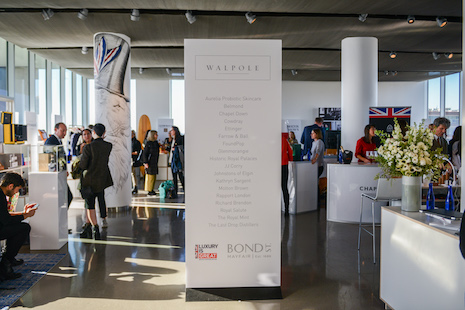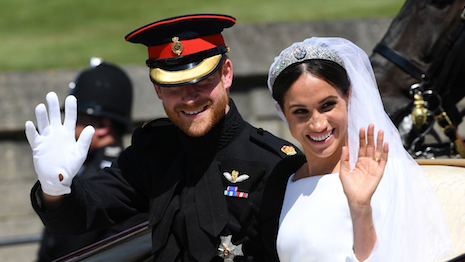 Johnstons of Elgin was among the brands in Walpole's delegation. Image credit: Johnstons of Elgin
Johnstons of Elgin was among the brands in Walpole's delegation. Image credit: Johnstons of Elgin
NEW YORK – As British brands look to move across the pond, the key to reaching American consumers is to more actively tell and show their stories.
From Oct. 23 to 25, luxury organization Walpole held its second annual Anglo-American Trade Mission to New York, with events aimed at boosting the profile of British luxury in the important United States market. The trip, undertaken in partnership with the GREAT Britain campaign and the U.K.'s Department for International Trade, was designed as a means to strengthen ties between British luxury and businesses, buyers and media in the U.S., showcasing national pride in the process.
“We feel a real sense of responsibility as a sector to fly the flag for Britain,” said Helen Brocklebank, CEO of Walpole.
Stateside tour
The U.S. is a significant market for British brands. In a roundtable discussion with Luxury Daily on Oct. 25, Richard Turner, HM consul and regional director east USA for Britain's Department of International Trade, explained that the U.S. is the largest market for exports from the United Kingdom.
A 2016 Walpole report by McKinsey found that 75 percent of Walpole's 250 member brands identify the United States as a key growth driver through 2021. Responding to Walpole members’ interest in the U.S. market, the organization brought a group of brands stateside last week.
“We’re going through a major divorce with one of our biggest trading partners, and it’s really for us to look outward now to where we go for new markets,” said Michael Ward, chairman of Walpole and managing director of Harrods.
Helen Brocklebank and Michael Ward at the Walpole Showcase on Oct. 25. Image courtesy of Walpole
Earlier this year, Walpole made a statement urging the U.K. government to protect jobs in the nation post-Brexit.
The group is hoping to see a pro-business Brexit to protect the country’s luxury business, which it says contributes 32.2 billion pounds, or $42 billion, to its economy (see story).
According to Ms. Brocklebank, the British luxury business stands out from those of other nations as it has a high-end segment across categories. For instance, France is primarily dedicated to fashion, while the U.K. has luxury brands in watchmaking, spirits, automotive and more.
This diversity of sectors was reflected in Walpole’s trade delegation to the United States. The 18 brands featured in a showcase on Oct. 23 included the more than 200-year-old cashmere label Johnstons of Elgin and storied whisky house Glenmorangie, as well as comparative newcomers such as Aurelia Probiotic Skincare and tableware label Richard Brendon, which were each founded about five years ago.
While some of the showcase brands have established footprints in the United States, others have more limited distribution. For instance, they may only sell online in the market or solely have a retail presence through wholesale partnerships.
This showcase and trip is therefore a means to feel out the market and explore opportunities for expanding. It’s also an opportunity to listen to what American consumers want, getting a sense for how luxury brands need to adapt and respond.
Walpole Showcase on Oct. 25. Image courtesy of Walpole
Beyond looking to reach Americans on U.S. soil, the trip is also about attracting U.S. tourists to Great Britain. American travelers are a valuable segment for inbound tourism, with the 3.9 million U.S. visitors to Britain in 2017 spending 3.64 billion pounds, or about $4.7 billion, according to Global Blue.
Travel to the U.K. has spiked in recent years, particularly after the change in exchange rate for the pound following Brexit.
Royalty revisited
British brands have a renewed opportunity in the United States thanks to the popularity of the royal family, according to new research by Walpole and Brand Finance, which was released as part of the overseas trip.
Alex Haigh, director of Brand Finance, noted that the young royals in particular are driving desirability. About three-quarters of Americans feel more positively about the U.K. than they did just two to three years ago, partly thanks to figures such as Kate Middleton and Meghan Markle.
Prince Harry and Meghan Markle's wedding has boosted interest in a number of fashion labels. Image credit: the royal family
This has been seen at retail, as consumers show an increased interest in buying the fashion that the duchesses wear.
HRH Prince Henry of Wales and Meghan Markle’s wedding saw significant buzz earlier this year.
Given the British luxury industry’s considerable ties to the royal family, brands frequently align themselves with major events in the their lives. The monarchy already provides a boost to the United Kingdom economy through brand positioning and tourism, but this year’s nuptial celebrations provided further benefit to luxury purveyors (see story).
Mr. Haigh said that while this pro-royalty sentiment exists, British brands should be careful how they celebrate their connection to the royal family, since part of what appeals about these figures is the fact that they are not commercial.
While the royal family is rooted in heritage, the younger generations of royals and pop culture are actually helping Britain appeal to millennials. Mr. Ward noted that the Netflix series “The Crown” has made the royalty seem more current.
Aside from royalty, Britain has cultural figures such as musicians and sports stars that help its national brand, and therefore the luxury houses that call the U.K. home.
Katie Thomas, associate director for Bond Street at New West End Company, pointed out that while the tales of royal warrants interest consumers, brands may want to think about expanding beyond this distinction to new storytelling.
Also, British brands sometimes shy away from sharing their stories, but often what is left unsaid will resonate with consumers.
Mr. Ward gave the example of Harrods' new tea tailor, which is now sharing more details about the provenance of the retailer's tea blends. Harrods had not thought to tell the story about its relationship with its supplier before, but this tale explains its business activities and makes it about more than the product.
“The thing I’ve learned in the last few days just being here... is not to be afraid to be bold at what we’re saying,” Ms. Brocklebank said. “The British personality can be quite modest, and diffident, and we’ve got an incredible story to tell.
"And what I’m hearing from everybody I meet in New York is 'Let’s just hear it a bit more loudly,'” she said. "We think we’re shouting, and it comes across as a whisper."



